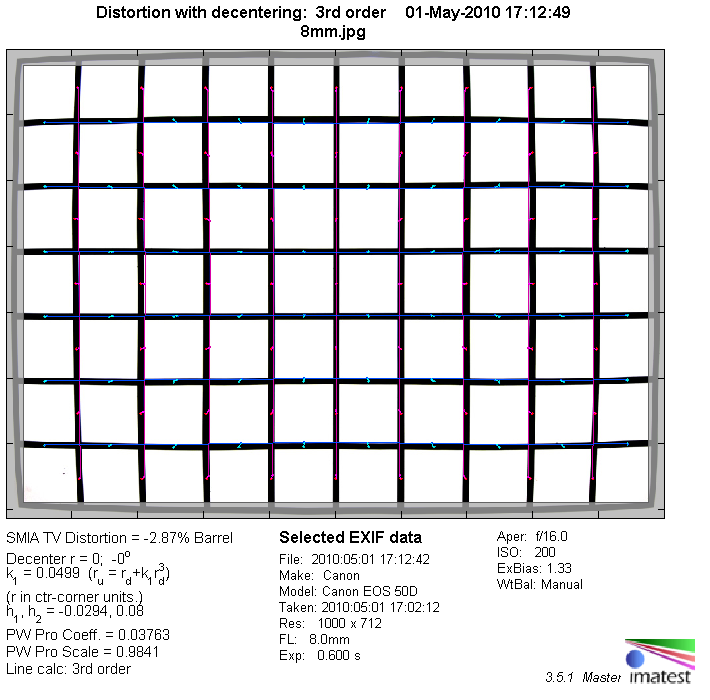|
Sigma AF 8-16mm f/4.5-5.6 DC HSM - Lab Test / Review - Analysis |
|
Lens Reviews -
Canon EOS (APS-C)
|
|
Page 2 of 2

Distortion
The AF 8-16mm f/4.5-5.6 produces a fairly heavy amount of complex barrel distortion (~2.9%) at 8mm. However, this is typical for ultra-wides and the Sigma is wider than usual to start with. The good news is that it shows basically no significant distortion from 12mm onwards although there's still a bit of a wavy sub-frequency left here.
|
Move the mouse cursor over the focal length text marks below to observe the respective distortion
|
| 8mm |
12mm |
16mm |

|
The chart above has a real-world size of about 120x80cm.
Vignetting
Ultra-wide lenses suffer from a given amount of "natural vignetting" (cos4 law of illumination falloff) so it's no surprise that the vignetting figures show worse results than usual here. The light fall off is worst at 8mm @ f/4.5, of course, and it's advisable to stop down to f/8 to tame the problem to an acceptable degree. The problem isn't as pronounced at other focal lengths but it makes sense to close the aperture a little here as well.

MTF (resolution)
The Sigma lens produced surprisingly impressive results in the MTF lab and that's throughout the entire zoom range. The sweet spot is at the 8mm settings where the center reaches outstanding levels followed by very good borders and corners. f/8 is the most harmonious setting if you want to achieve a very even quality across the frame. The center isn't quite as impressive at 12mm and 16mm but the general characteristic remains the same here.
Unfortunately we need to report that the centering quality of the tested sample was less than stellar.
You may wonder about the strange "curve" of the center performance here. Please note that f/4-5.6 is the APS-C sweet spot where diffraction has no real impact yet and (center) aberrations are already well corrected. The Sigma is a "slow" lens so the curve for the center is only "falling" the more you stop down.
Please note that the MTF results are not directly comparable across the different systems!
Below is a simplified summary of the formal findings. The chart shows line widths per picture height (LW/PH) which can be taken as a measure for sharpness.
If you want to know more about the MTF50 figures you may check out the corresponding Imatest Explanations
Chromatic Aberrations (CAs)
It's interesting to have a look at the lateral CAs (color shadows at harsh contrast transitions) because this is where the new FLD elements are supposed to improve the situation. Previous Sigma ultra-wide lenses had quite some problems here but the AF 8-16mm f/4.5-5.6 DC HSM is indeed a good performer. Lateral CAs are very well controlled across the range. At an average width of around 1px at the image borders the issue may be noticeable at 100% image magnification but it's not really an issue anymore on prints.

Verdict
The Sigma AF 8-16mm f/4.5-5.6 DC HSM may be the new star in this lens segment. It's very sharp across the whole range straight from the max. aperture. Lateral CAs are also very well controlled. That's quite an achievement for such an extreme ultra-wide angle zoom lens! If you're into architecture photography you will notice some barrel distortions when using the 8mm setting but that's actually a general problem in this class and at 12mm it shows less distortions than the competition actually. The biggest issue is the amount of vignetting at the widest setting but that's not really a surprise because the inherent amount of natural vignetting is unavoidable at such extreme focal lengths. However, it's still a good idea to avoid the max. aperture to tame the light fall-off to some degree.
The build quality of the Sigma lens is very good although some may not like the vulnerable "bulb"-like front element which prohibits the use of filters. The AF is both fast and nearly silent. The pricing of the Sigma is very attractive relative to its performance figures as well as the extreme nature of the lens. Therefore ... highly recommended (if you can find a good sample)!
|